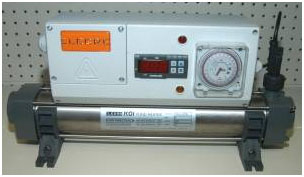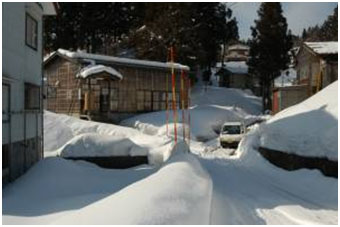Despite what many may profess, Koi are not a true cold water species as are Golden Orfe, Sturgeon, Goldfish and some other species of native fish that dwell in garden ponds.
(Yes, many Koi do survive a UK winter but many more do not.)
The ones we see very motionless and huddled together on the pond base during a cold UK winter are very unhappy indeed, in fact they are in agony – please take my word for this!
Another myth we hear with regularity is that our Koi ‘hibernate’ – again take my word, Bears do, Hedgehogs do, tortoises do but Koi and ALL other species of fish life most certainly do NOT!)
Koi bred in Japan are grown in warm, outdoor mud ponds from June until October and then harvested.

Japanese indoor, heated Koi house used for sales and over-wintering of stocks
They are then kept in indoor, heated glass or clear polycarbonate houses throughout the harsh winter months for protection against outdoor temperatures.
All Koi imported from Japan today have rarely experienced water temperatures below 60F (15C).
However we should try to give our Koi the four seasons of the year but certainly not as harsh as our outdoor UK ambient temperatures dictate. Ideal water temperature parameters are as follows:-
-
Winter – (December to February) Minimum 50F or 9.9C
-
Spring – (March to May) 55F (12.7C) rising to 60F (15.5C)
-
Summer – (June to August) 64F (18C) up to 77F (25C) then slowly down to 68F (20C)
-
Autumn – (September to November) 68F (20C) slowly down to 59F (15C)
Certainly some form of heating should be incorporated in the UK even if this is only in emergency for the odd, rare days of very low temperatures. In recent years our winters are becoming milder but I would advise an in-line electric heater to be fitted if only as a safety measure. If this is ever needed for a few days, it is comforting to know that heat is instantly available.
 Small systems, well-insulated, can get by with two or more 300w placed into the flow of the filter whilst larger, insulated systems can use in-line electric 3kw to 6kw heaters working on a thermostat to achieve and maintain the desired temperature.
Small systems, well-insulated, can get by with two or more 300w placed into the flow of the filter whilst larger, insulated systems can use in-line electric 3kw to 6kw heaters working on a thermostat to achieve and maintain the desired temperature.
As to much larger systems, natural gas powered heating units and stainless steel heat exchangers are the usual choice and work in much the same way as domestic heating.
In general, our winters are not nearly so severe as in years gone by. Koi kept in these conditions and fed as recommended on this site will come out of winter in perfect condition whereas Koi left to the UK winter elements without any added heat usually show significant health problems during spring as water temperatures begin to rise naturally.
 This photograph shows a Japanese breeder’s Koi house for his stocks to be kept from early October through to late May. The ponds are kept at the required water temperatures with a simple oil-fired heater sytem.
This photograph shows a Japanese breeder’s Koi house for his stocks to be kept from early October through to late May. The ponds are kept at the required water temperatures with a simple oil-fired heater sytem.



